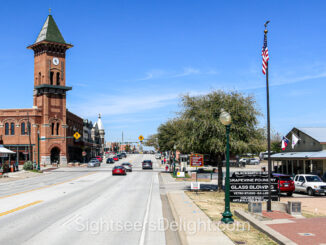SAN ANTONIO, Texas — Europeans colonizing what is today Texas starting in the 17th century built stunning missions that rival their cathedral counterparts in Europe.
The missions, today a part of San Antonio Missions National Historical Park, serve as important artifacts in the study of how Europeans colonized the region just 200 years after Christopher Columbus “discovered” the new world.
One of these missions, San Antonio de Valero (better known as The Alamo), earned its place in history after a famous battle there in 1836. While itself an important destination, visitors to San Antonio would be remiss not to take the opportunity to explore four additional missions that have stood the test of time.
The missions, which operated until the late 18th century, were built as self-sufficient communities that included farming operations. There, missionaries also converted natives to Christianity and taught them the Spanish way of life.

The largest of these missions, Misión San José y San Miguel de Aguayo, was established in 1720. Construction of the mission was completed in 1782, and the native Coahuiltecan workers used Texas limestone and brightly colored stucco to give the building its distinctive look.
According to the National Park Service, about 80 percent of the mission that visitors see today is original. The Works Progress Administration reconstructed much of the area during the 1930s.
The mission’s most popular attribute is the picturesque “Rose Window.” Sculpted around 1775, the window is often cited as a great example of Spanish Colonial ornamentation.
The stunning Mission Nuestra Señora de la Purisima Concepción de Acuña, often called Mission Concepcion, is often said to look similar to its appearance in 1755, the year the church was dedicated. Today, the mission is one of the best-preserved missions in Texas.
Originally built to convert Hasinai and also to serve as a buffer against a feared French invasion from Louisiana, the mission was the site of the October 1835 Battle of Concepción. That battle was one of the first of the Texas Revolution.
The mission was originally covered inside and out by frescos. While the exterior paintings have faded, frescos are still visible inside the mission.

A third mission, the Misión San Juan Capistrano, was established in 1716 as Misión San Jose de los Nazonis. The mission is identifiable by its bell tower, built circa 1756.
A few years later, the mission kicked off an expansion project to build a larger church. That project, however, was never completed because of a shortage of sufficient labor.
The last mission, Misión San Francisco de la Espada, was the first mission established in Texas. Founded in 1690 as San Francisco de los Tejas, the mission was originally located near what is today the town of Alto.
The mission moved to its current location in March 1731. The priest’s residence (or friary) was completed in 1745 while the church was completed in 1756.

Much of the mission burned in 1826. The centerpiece of today’s Misión Espada is the former chapel.
Franciscan friars in 1731 built an aqueduct as part of a 15-mile-long network to supply water for irrigation. The remarkable Espada Acequia, which remains in use today, is an Historic Civil Engineering Landmark.
While not connected to the mission, one other site in downtown San Antonio also provides a unique look into the 18th century life in modern day south-central Texas.
The Spanish Governor’s Palace was built in 1722, according to some sources, and greatly expanded over the years. The palace was an office and residence for captains of the Spanish military garrison in the Presidio San Antonio de Béjar.




